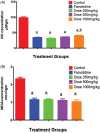Anti-inflammatory and gastroprotective potential of leaf essential oil of Cinnamomum glanduliferum in ethanol-induced rat experimental gastritis
- PMID: 28447506
- PMCID: PMC7011983
- DOI: 10.1080/13880209.2017.1314512
Anti-inflammatory and gastroprotective potential of leaf essential oil of Cinnamomum glanduliferum in ethanol-induced rat experimental gastritis
Abstract
Context: Nothing could be found in the literature concerning Cinnamomum glanduliferum (Wall) Meissn (Lauraceae) bark (CG) in Egypt.
Objective: To investigate CG volatile oil chemically and its anti-inflammatory and gastroprotective effects.
Materials and methods: Essential oils were investigated by GC-MS. Leaves oil was assessed at doses of 250, 500 and 1000 mg/kg for its anti-inflammatory effect against carrageenan-induced rat oedema model. Serum inflammation markers were measured. The gastro-protective effect of the same doses of the volatile oil was also tested in ethanol-induced non-ulcerative gastritis model in rats. Stomach oxidative stress markers were examined following 1 h after intragastric ethanol administration.
Results: Twenty-five and 20 compounds were identified from leaf and branch oils, respectively (98.85 and 99.13%). The major ones were: eucalyptol (59.44%; 55.74%), sabinene (14.99%; 7.12%), α-terpineol (6.44%; 9.81%), α-pinene (5.27%; 4.71%). Following 4 h of treatment leaves volatile oil at doses of 250, 500 and 1000 mg/kg significantly reduced paw volume to 94, 82 and 69%, respectively. The same doses significantly reduced COX-2 activity to 73.8, 50.7 and 21.4 nmol/min/mL, respectively. A significant reduction of PGE2 concentration was observed (2.95 ± 0.2, 2.45 ± 0.15 and 1.75 ± 0.015 pg/mL). CG oil exhibited a significant modulatory effect on ethanol-induced gastritis in rats as the level of NO reduced to 32, 37 and 41 μM nitrate/g and also a significant inhibition of lipid peroxidation was observed via reduction of MDA concentration (1.15, 1.11 and 1.04 nmol/g).
Conclusion: CG volatile oil exhibited an anti-inflammatory effect and protected against ethanol-induced non-ulcerative gastritis.
Keywords: GC-MS; PGE2; inflammation; lipid peroxidation; oxidative stress.
Figures




References
-
- Adams RP. 2007. Identification of essential oil components by gas chromatography/mass spectrometry. Illinois, USA: Allured Publishing Corporation.
-
- Agrawal R, Pant AK, Prakash O.. 2012. Chemistry of phytopotentials: health, energy and environmental perspectives: Chemical composition and biological activities of essential oils of Cinnamomum tamala, Cinnamomum zeylanicum and Cinnamomum camphora growing in Uttarakhand. Berlin Heidelberg: Springer; p. 87–92.
-
- Al-Shabanah OA. 1997. Effect of evening primrose oil on gastric ulceration and secretion induced by various ulcerogenic and necrotizing agents in rats. Food Chem Toxicol. 35:769–775. - PubMed
-
- Amaral GP, de Carvalho NR, Barcelos RP, Dobrachinski F, Portella Rde L, da Silva MH, et al. . 2013. Protective action of ethanolic extract of Rosmarinus officinalis L. in gastric ulcer prevention induced by ethanol in rats. Food Chem Toxicol. 55:48–55. - PubMed
-
- ArunKumar R, Nair SA, Rameshkumar KB, Subramoniam A.. 2014. The essential oil constituents of Zornia diphylla (L.) Pers, and anti-inflammatory and antimicrobial activities of the oil. Rec Nat Prod. 8:385–393.
MeSH terms
Substances
LinkOut - more resources
Full Text Sources
Other Literature Sources
Research Materials
Miscellaneous
